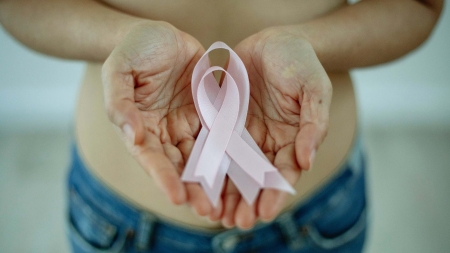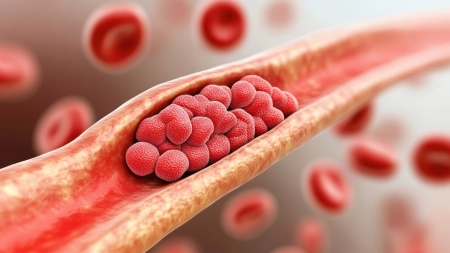Key questions on the topic of breast cancer
Breast cancer is the most frequently occurring type of cancer in women – and in rare cases, also men. Nine out of ten sufferers can be treated successfully.

How common is breast cancer?
Breast cancer is by far the most common type of cancer in women: around one in eight women will contract it at some point in their lives. Over 6,200 women are diagnosed with breast cancer every year, i.e. roughly around one in 700 women. That may not sound like a lot, but almost one in three cancers in women affects the breast. Breast cancer kills around 1,400 women in Switzerland every year. However, the risk is very unevenly distributed.
What risk factors are associated with breast cancer?
Women can exert an influence on some of the risk factors for breast cancer, while others are a matter of genetics. "Lifestyle factors such as maintaining a balanced diet, keeping alcohol consumption to a minimum and engaging in regular exercise can reduce the risk to a certain extent. But you can't prevent it one hundred per cent", says Cornelia Leo, Head of the Interdisciplinary Breast Centre at Kantonsspital Baden.
Age is the most important risk factor: the vast majority of breast cancer occurs in patients aged 50 and over. Sex hormones also play an important role. "The risk of getting breast cancer tends to be higher if menstruation starts early in life or the menopause starts late", adds Leo. However, in most cases of breast cancer, there is no single underlying cause and several unfavourable factors have to combine in order for breast cancer to develop.
For around one in five women affected, other family members will develop breast cancer at some point in their lives. In fact, five to ten out of every 100 cases of breast cancer are caused solely by specific genetic mutations that can be inherited and are detectable via genetic testing.
The famous US actress Angelina Jolie has what is called BRCA1/BRCA2 or the "breast cancer gene". Women with this genetic mutation have a very high risk of developing breast cancer.
"We recommend that women from "high-risk families" like these undergo annual screening involving an MRI scan or even preventive surgery from the age of 25", says Cornelia Leo. She advises women who do not have a high incidence of breast cancer in their families to attend breast cancer screening from the age of 50 onwards.
How does breast cancer screening work?
Gynaecologists generally recommend that all women between the ages of 50 and 69 should have a mammogram every two years. It involves taking X-ray pictures of both breasts. Although it cannot prevent breast cancer, it can detect it at an early stage. This is because tumours frequently feature tiny calcium deposits that are visible on X-rays – and this is usually the case long before the cancer manifests itself in the form of symptoms.
Opinions differ on the benefits of mammograms. Critics highlight the fact that it does not go far enough and unnecessarily gives some women a scare due to "false-positive" findings. The mammogram shows something suspicious, but after further examinations it turns out to be harmless.
According to the German "IQWiG" Institute , mammograms produce on average a normal result in 970 out of 1,000 women, six women are diagnosed with breast cancer and 24 are initially suspected of having breast cancer, but this is subsequently not confirmed after further tests.
Claudia Rauh, Head of Senology at the University Clinic for Gynaecology at Inselspital Bern, believes that screening is important. (Senology means the "study of the breast".) "Breast cancer can now be successfully treated in almost nine out of ten women. The chances of this happening are all the better if it is found early. Unfortunately, we quite often see women who only come to us when the breast cancer is at an advanced stage", says Rauh.
However, gynaecologists and mammogram critics do agree on one thing: if women do opt to have this examination, it is best done at a certified centre. The teams who work there are highly experienced and have to meet high quality standards. "The results from certified breast centres are better", says Claudia Rauh.
Many breast tumours are discovered either by women or their partners. Nevertheless, self-examination is not suitable as a means of detecting breast cancer at an early stage. This is because tumours can usually only be felt once they have grown quite large. Therefore, self-examination does not reduce the breast cancer mortality rate. Despite this, breast health specialist Claudia Rauh believes that regular examination of the breasts is a good idea "because it helps women develop a better feeling for their bodies". This means that any new lumps in the breast will be noticed more quickly.
What symptoms are associated with breast cancer?
Cornelia Leo’s advice: "every woman should have any lumps, changes in the shape, dimpling, reddening of the skin of the breasts or discharge from the nipples checked out as soon as possible". This also applies to men: for every 100 women who get breast cancer, one man will be affected by the disease. You should get advice if you notice an increase in size, a hardening of the breast tissue or an enlarged lymph node in your armpit.
Tumours that remain undetected for a long time can eventually develop into a tumour that breaks through to the surface of the skin, fails to heal and continues to grow.
How is breast cancer treated?
Deciding which treatment is best depends on the biological properties of the tumour and how far it has spread. It nearly always involves surgery. However, in four out of every five women breast removal will not be necessary.
Anti-hormone therapy, chemotherapy and/or radiotherapy are also used. An overview can be found on the www.onkopedia.com website. Today, cancer specialists know that breast cancer is not one single disease, but that there are many "subtypes", each of which is treated differently. Tumour cells that respond to sex hormones or have certain surface properties, for example, often have a better prognosis than those that do not.
What are the chances of breast cancer being treated successfully?
Breast cancer usually responds well to treatment when the therapy is adapted to the tumour and the patient. "89 per cent of breast cancer cases can now be treated successfully. Enormous progress has been made in treatment over the past 15 years", adds Claudia Rauh. If a tumour has spread, it can no longer be cured, but its progression can be halted. "There are new treatments in this area, too. Breast cancer is increasingly becoming a chronic disease that women can live with for many years".


